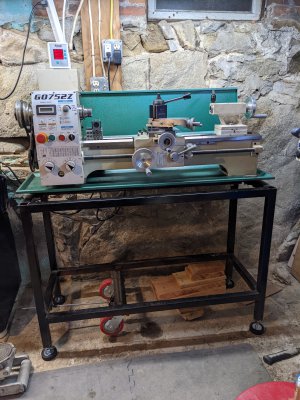- Joined
- Dec 18, 2019
- Messages
- 6,447
After getting my (new to me) lathe down into the basement and in place I was looking at leveling the lathe. It's grossly leveled with a carpenter level, but nowhere near level according to my machinist level. (0.02mm/m sensitivity.) One thing I noticed was the forward and backward level seems to change depending on where the carriage is positioned, which I found a bit amusing. Like how can one get anything level that way?
Right now, the headstock is higher than the tailstock, but I can fix that with a bit of patience. Of course, that doesn't matter, it's the twist we are trying to take out. So to proceed, is it better to install the chuck, carriage and compound and tailstock and then do the leveling? Or strip it? Yes the level is very sensitive. I don't mind waiting for it to settle. But I don't want to level it bare and find out it changes loaded. Lathe is a Grizzly G0752Z/G0602. Lathe is sitting on rough lime cement floor.

Right now, the headstock is higher than the tailstock, but I can fix that with a bit of patience. Of course, that doesn't matter, it's the twist we are trying to take out. So to proceed, is it better to install the chuck, carriage and compound and tailstock and then do the leveling? Or strip it? Yes the level is very sensitive. I don't mind waiting for it to settle. But I don't want to level it bare and find out it changes loaded. Lathe is a Grizzly G0752Z/G0602. Lathe is sitting on rough lime cement floor.


